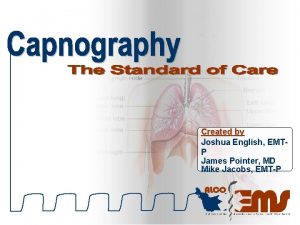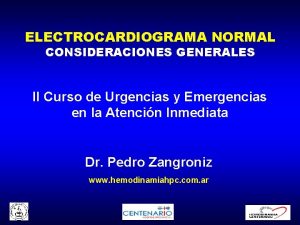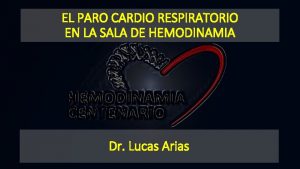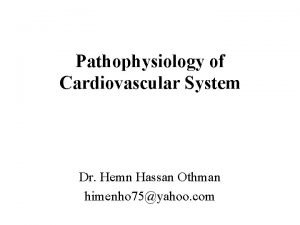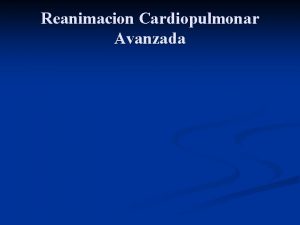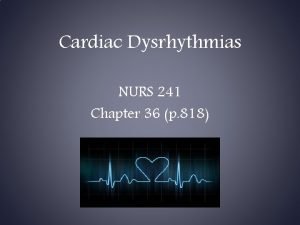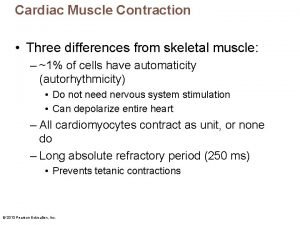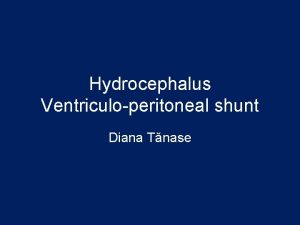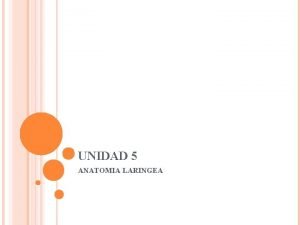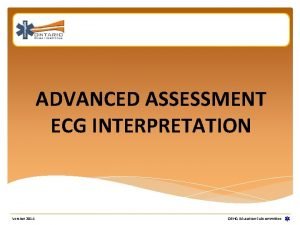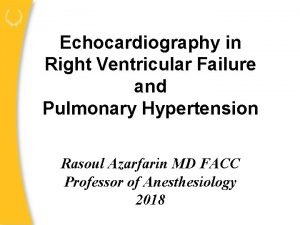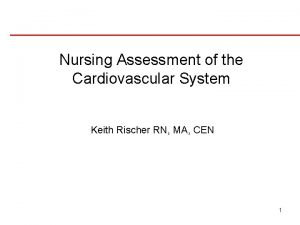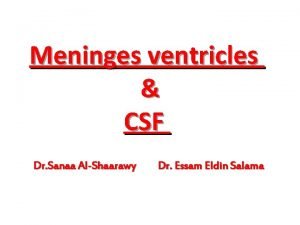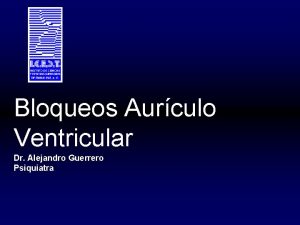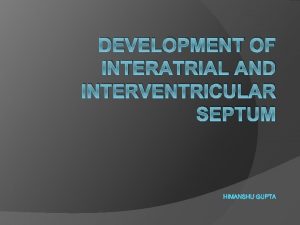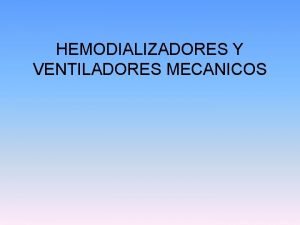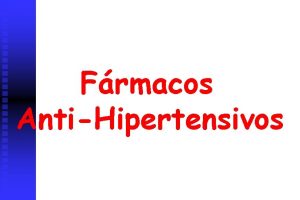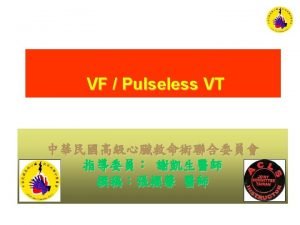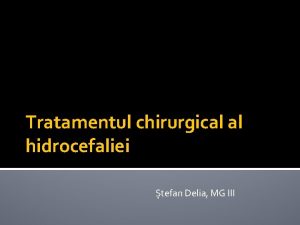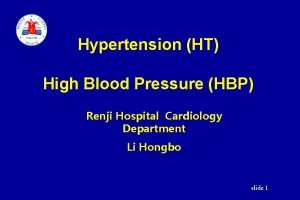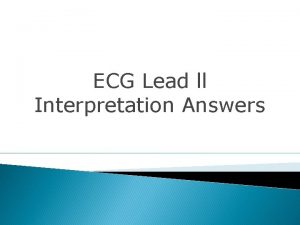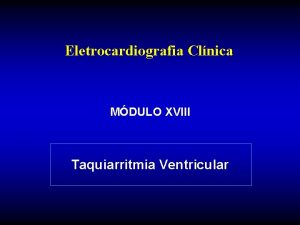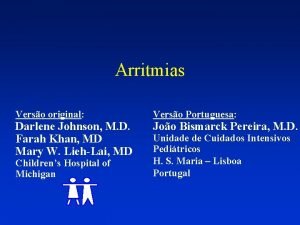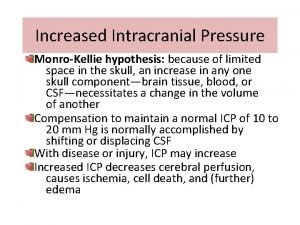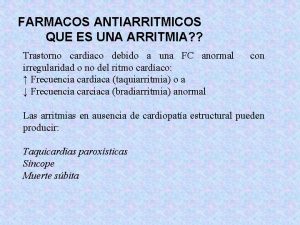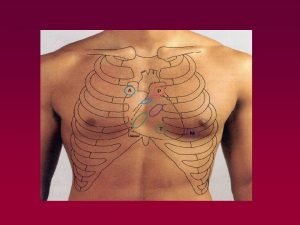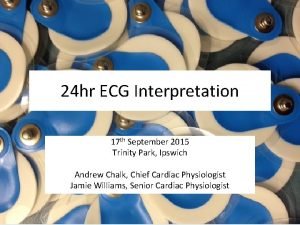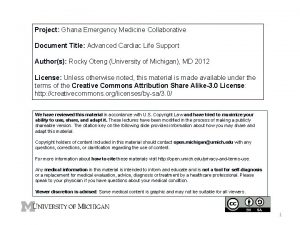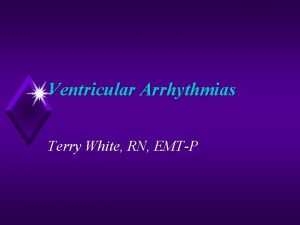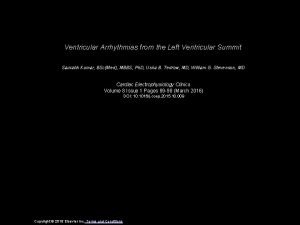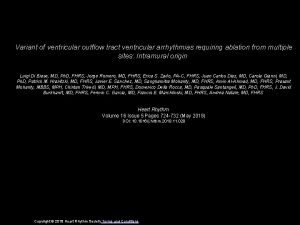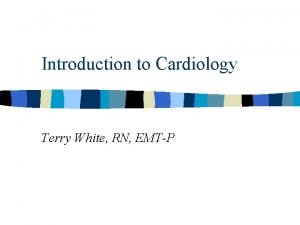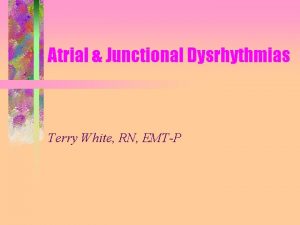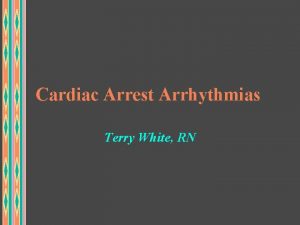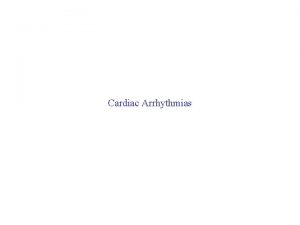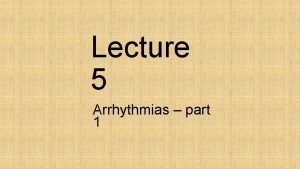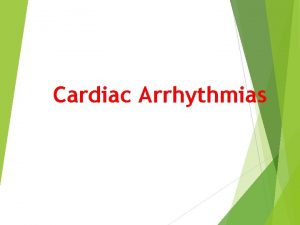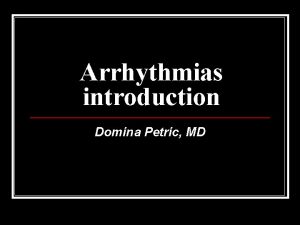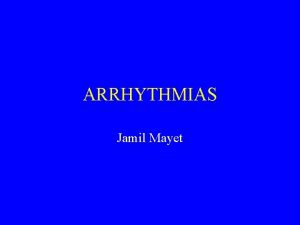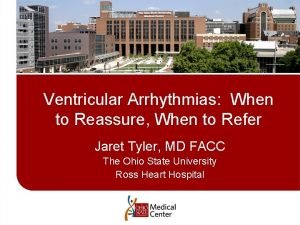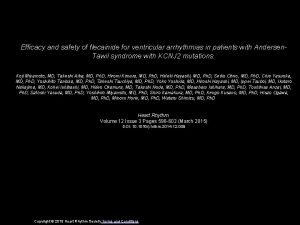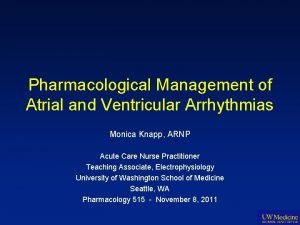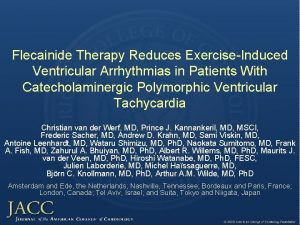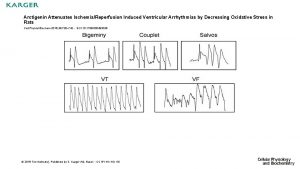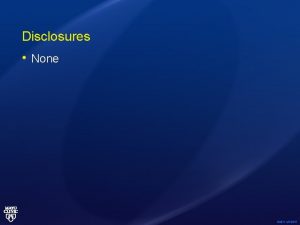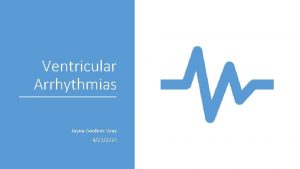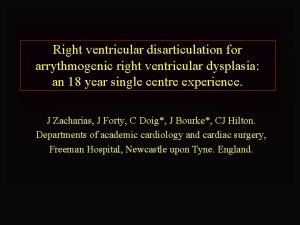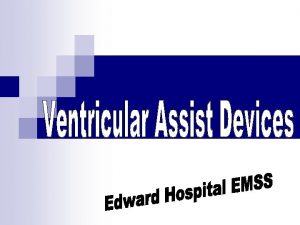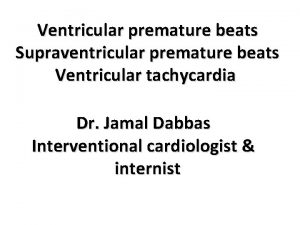Ventricular Arrhythmias Terry White RN EMTP Analyze the
































- Slides: 32

Ventricular Arrhythmias Terry White, RN, EMT-P

Analyze the Rhythm

Analyze the Rhythm

Analyze the Rhythm

Premature Ventricular Complexes (PVCs) u Definitions u Early depolarization of the ventricles u Occur as a result of automaticity or reentry u A PVC is a characteristic of an underlying ECG rhythm u PVC is not the name of a dysrhythmia

Premature Ventricular Complexes u Causes u Hypoxia u Myocardial Ischemia u Electrolyte Imbalance u Digitalis Toxicity u Stimulants u Chronic Heart Disease (CHF, COPD)

Premature Ventricular Complexes (PVCs) u Characteristics u Complex is earlier than expected u Wide QRS (wide is not always ventricular) u OFTEN has a compensatory pause u Usually irregular u Not preceded by a P wave u T wave opposite deflection u May or may not result in perfused beat

Premature Ventricular Complexes (PVCs) u. More Terms to Know u. Unifocal, Multifocal u. R on T Phenomenon u. Bigeminy, Trigeminy, Quadrigeminy, Couplet

Premature Ventricular Complexes (PVCs) u PVCs are not always dangerous u Common for some people u Consider treating PVCs if: u >6/minute u Severe associated with: Chest pain u Hypotension, Decreased Perfusion u Shortness of Breath

Premature Ventricular Complexes (PVCs) u Treat PVCs if consistently see any of the following with other symptoms: u Multifocal u Ventricular Couplets u Runs of Ventricular Tachycardia u R on T Phenomenon (Malignant PVCs)

Premature Ventricular Complexes (PVCs) u Management (Rate <60) u Oxygen & Ventilation are initial treatments for ALL ectopic beats u ECG Monitor, IV NS TKO u assess u Treat the underlying rhythm like bradycardia u Atropine u TCP u Dopamine

Premature Ventricular Complexes (PVCs) u Management (Rate >60) u Oxygen & Ventilation are initial treatments for ALL ectopic beats u ECG Monitor, IV NS TKO u assess u If the underlying rhythm symptomatic (see previous):

Premature Ventricular Complexes (PVCs) u Management (Rate >60) u Lidocaine u IV Bolus, 1 - 1. 5 mg/kg u Infusion, 1 - 4 mg/min u Repeat IV push 0. 5 - 0. 75 mg/kg every 5 minutes to 3 mg/kg max u Increase Infusion 1 mg/min for every 1 mg/kg IV bolus given

Premature Ventricular Complexes (PVCs) u Management (Rate >60) u Procainamide u 20 mg/min IV until: PVCs suppressed u 17 mg/kg given u Hypotension occurs u QRS widens by 50% or more u u Continuous infusion at 1 - 4 mg/min

Premature Ventricular Complexes (PVCs) u Management (Rate >60) u Bretylium u IV push, 5 mg/kg slowly u Infusion, 1 - 2 mg/min u Used less frequently today due to supply shortage

Analyze the Rhythm

Idioventricular Rhythm u Causes u Myocardial ischemia u Hypoxia u High vagal tone u Drug effects

Idioventricular Rhythm u Characteristics u. A ventricular focus takes over as an escape pacemaker site u Rate 20 - 40 bpm u Wide QRS complexes u No P waves

Idioventricular Rhythm u Management u Slow rate will probably decrease cardiac output u Usually a later and often pre-terminal rhythm u If symptomatic, treat as unstable bradycardia u Do NOT give Lidocaine or other ventricular antidysrhythmics!!!!!!!

Analyze the Rhythm

Accelerated Idioventricular Rhythm u Characteristics u Like Idioventricular rhythm except for rate u Rate, greater than 40 bpm but less than 100 bpm

Accelerated Idioventricular Rhythm u Management u Patient may maintain adequate cardiac output u Identify underlying cause and treat!!! u Monitor cardiac output and perfusion u Often u Do a late and pre-terminal rhythm NOT give Lidocaine or other antidysrhythmics!!!!!!!

Analyze the Rhythm

Ventricular Tachycardia (VT) u Causes u Myocardial ischemia u Hypoxia u Electrolyte imbalance u Digitalis toxicity u Myocardial trauma

Ventricular Tachycardia (VT) u Characteristics u Pacemaker site Irritable ventricular focus takes over as pacemaker site, OR u May result from multiple ventricular foci attempting to become pacemaker site u u Complexes look similar to PVCs u May see P waves before complexes but uncommon u Rate, usually between 100 and 250 bpm

Ventricular Tachycardia (VT) u Complications u Can decrease cardiac output u Increases cardiac workload u Decreases coronary perfusion u Can quickly deteriorate into V-fib

Ventricular Tachycardia (VT) u Types u Monomorphic u QRS complexes all have same morphology u Polymorphic u QRS complexes have more than one morphology u “Torsades de Pointes” u “Twisting of the points” u Usually > 200 bpm u Susceptible if slow repolarization (long QT)

Ventricular Tachycardia (VT) u Treatment of Stable and Unstable u Oxygen, Ventilations, Assess Pulse u ECG Monitor u If u IV unstable, proceed to synchronized cardioversion NS TKO u Determine monomorphic vs polymorphic u If wide complex of unknown origin, attempt 12 lead ECG to determine

Ventricular Tachycardia Treatment: Monomorphic u Treatment of Stable (limit to one antidysrhythmic) u procainamide u avoid 20 mg/min IV if poor cardiac function u amiodarone 150 mg slow IV (15 mg/min) u lidocaine 1. 0 mg/kg IV (max 3. 0 mg/kg) u Begin with 0. 5 - 0. 75 mg/kg poor cardiac function u Follow with lidocaine infusion, 1 - 4 mg/min u synchronized cardioversion

Tachycardia: Wide Complex (VT) Polymorphic (Torsades) u Treatment u Normal (limit to one antidysrhythmic) QT u Lidocaine, 1 - 1. 5 mg/kg IV (max 3. 0 mg/kg), repeat @ 0. 5 -0. 75 mg/kg q 5 min to max 3 mg/kg u Amiodarone, 150 mg slow IV (15 mg/min) u Procainamide, 20 mg/min until PVCs suppressed u 17 mg/kg given u Hypotension occurs u QRS widens by 50% or more u Then, infusion at 1 - 4 mg/min u

Tachycardia: Wide Complex (VT) Polymorphic (Torsades) u Treatment u Long (limit to one antidysrhythmic) QT (including Torsades w/o arrest) u Magnesium sulfate 10%, 1 -2 g slow IV over 5 mins or greater u Lidocaine, 1 - 1. 5 mg/kg IV (max 3. 0 mg/kg), repeat @ 0. 5 -0. 75 mg/kg q 5 min to max 3 mg/kg u Other considerations u phenytoin, isoproterenol, or overdrive pacing

Interesting Questions What is a capture beat? What is a fusion beat? How do they help or hurt you in your ECG interpretation?
 The emtp quiz
The emtp quiz Interpretacion de electrocardiograma
Interpretacion de electrocardiograma Taquicardia ventricular polimorfa
Taquicardia ventricular polimorfa Ventricular wall aneurysm
Ventricular wall aneurysm Actividad eléctrica sin pulso tratamiento
Actividad eléctrica sin pulso tratamiento Capture beat
Capture beat Coarse ventricular fibrillation
Coarse ventricular fibrillation Heart contraction sequence
Heart contraction sequence Fibrilação ventricular
Fibrilação ventricular Ventricular shunting
Ventricular shunting Craqueo laringeo
Craqueo laringeo Normal sinus rhythm with pjc
Normal sinus rhythm with pjc Elevated right ventricular systolic pressure
Elevated right ventricular systolic pressure Apetm heart sounds
Apetm heart sounds Ventricular system
Ventricular system V flutter
V flutter Taquicardia ventricular polimorfa
Taquicardia ventricular polimorfa Ventricular septum development
Ventricular septum development Fibrilacion ventricular
Fibrilacion ventricular B-bloqueadores
B-bloqueadores Left ventricular hypertrophy
Left ventricular hypertrophy Acls vt
Acls vt Drenaj ventricular extern
Drenaj ventricular extern Left ventricular hypertrophy
Left ventricular hypertrophy Ventricular standstill ecg
Ventricular standstill ecg Taquicardia ventricular monomórfica
Taquicardia ventricular monomórfica Antiaritmice clasificare
Antiaritmice clasificare Taquicardia supraventricular
Taquicardia supraventricular Signs of increased intracranial pressure
Signs of increased intracranial pressure Irbesartran
Irbesartran Y
Y Trigeminy ecg
Trigeminy ecg Fine v fib vs asystole
Fine v fib vs asystole
